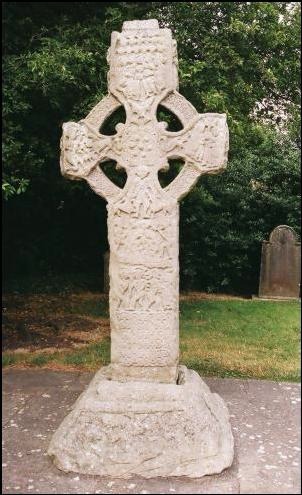 This page highlights several of the Irish High Crosses that have scenes that are secular in their content or that could have a secular or a biblical reference.
This page highlights several of the Irish High Crosses that have scenes that are secular in their content or that could have a secular or a biblical reference.
The scenes we examine here may fall in the category of the biblical or the secular. Henry S. Crawford writes: “The secular scenes represent persons fighting, hunting, traveling, playing musical instruments and going through various ceremonies, the meaning of which is often doubtful.” (Crawford p. 68) Others, as we shall see, hold out for biblical meanings for at least some of the scenes.
To the left, Kells South Cross (Cross of Patrick and Columba) County Meath, East Face.
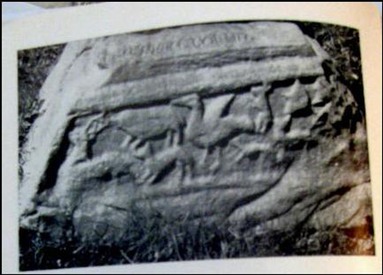
Scenes with Animals
Kells South Cross; Hunting Scene or Noah drives animals to the Ark: While the lower right corner is damaged, the scene to the right depicts a man with a shield moving toward a group of animals who are moving away from him. J. Romilly Allen points out that scenes such as this are “not so obviously Scriptural as those on the shafts and heads, and in this respect, . . . have more in common with the crosses of the East of Scotland.” (Allen p. 229) The crosses and cross slabs he refers to have numerous hunting scenes, battle scenes and processionals that appear to reflect events of the general time the scenes were carved.
The uncertainty of identification, however, allows Helen Roe, and others, to suggest this may depict Noah driving the animals into the ark (Genesis 7). (Roe p. 13)
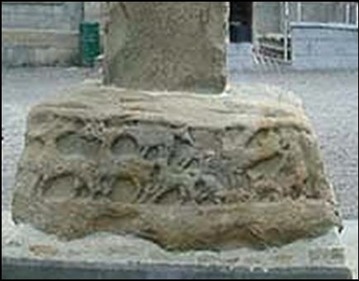
Kells Market; Deer Hunt or Noah driving animals to the Ark: This scene to the left, from a second cross at Kells is very similar to the one above. Because the cross has been moved and realigned, scholars, such as Peter Harbison, assign this scene to the north face (the direction it now faces). (Harbison p. 103) Others, including Helen Roe assign it to the west face, as indicated here (the presumed original orientation). (Roe p. 35)
“On the right a man bearing a long staff and a trident (?), a dog at his feet. Moving before him from right to left are: (1) a large bird with open wings; (2) a frog; (3) a fawn (?); (4) a young bull (?); (5) a boar; (6) two fine stags with spreading antlers.” (Roe p. 35)
Like the scene above, this is most likely a hunting scene. It has, however, also been interpreted as Noah driving the animals into the ark. If these two scenes are biblical in nature, the identification is almost certainly correct. But are they intended to represent the biblical story?
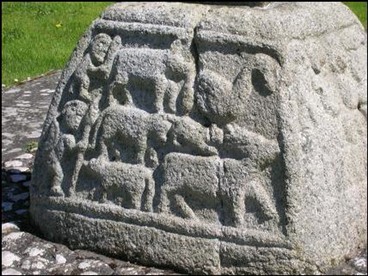
Castledermot; Hunting scene or Noah driving animals to the Ark: The scene to the left contains two men, one above the other. The lower man seems to have a shield on his back and carries a spear. The upper man carries a club. They hunt or herd a group of animals. Peter Harbison suggests the animals include two of uncertain type (one turned toward the lower man); a hare above a deer, a pig or boar and a bird. (Harbison p. 39)
Like the scenes above, several scholars have suggested this may represent Noah driving the animals into the ark. (See Henry p. 41)
Because of the weapons the men carry, it is safer to suggest the scene represents a hunt and is not biblical in nature. As with the scenes above, either, however, is possible.
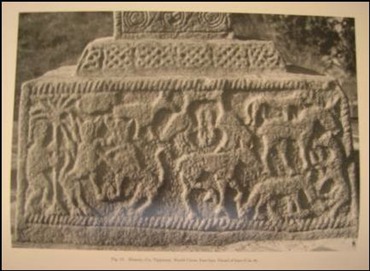
Ahenny North; Adam Naming the Animals [Harbison photo Vol. 2]: In this scene we have a jumble of animals that fill most of the frame. To the left a man stands under what appears to be a palm tree. This is clearly not Noah driving the animals. But what is it?
Henry Crawford writes, “The man stands under the palm and appears to watch rather than to hunt the animals; the subject may therefore be Adam naming the beasts. It may be mentioned, as having a bearing on this identification, that the palm tree used as an accessory often indicates that the scene represents Paradise.” (Crawford p. 68)
Others have suggested this may represent a hermit in his retreat, a temptation scene, or God creating the birds and beasts. All of these suggestions seem far less likely than Adam naming the animals.

Processions
Kells Market; Horseman with Swords and Shields: Here we have another set of carvings that do not have any clear relationship with the Bible. While their meaning on the crosses is obscure, it is worth noting that most of them reflect the kind of men (the warrior class) that would have served as patrons to the monasteries.
In the scene at right “Four horsemen ride, one after the other, from right to left. Each carries a short sword and a round shield with a central boss.” (Roe p. 28)
These horsemen are of the warrior class. They carry short swords (at least 27 inches long). The round shields are not of the oval type preferred by most Celtic warriors but are not without parallel in archeological finds. Foot soldiers seem to have preferred long oval shields that protected more of their bodies. Celtic warriors also used spears, broad bladed for thrusting and javelin type for throwing. (Konstam p. 114-115)

Clonmacnois Scripture; Chariots and Horsemen [Harbison photo Vol 2]: Kenneth MacGowan describes these scenes as follows: “The base of the cross on this side has two items — the upper being three horsemen riding in a southerly direction while the lower part has two chariots heading northwards.” (MacGowan p. 40)
Celtic warriors did use chariots. There are two people in each. One drives, the other is a warrior/fighter.
In an effort to make a possible biblical link for these two scenes C. O’Sabhaios suggests the lower scene may represent the Exodus. Here we would have the Egyptians pursuing the Hebrews. A. Kingsley Porter suggests the three upper figures may represent the Magi on their way to honor the Christ child. Francoise Henry offers the possibility that the horsemen represent the bringing of the Christian faith to Ireland. There are no indications in the artwork that clearly suggest any of these possibilities.
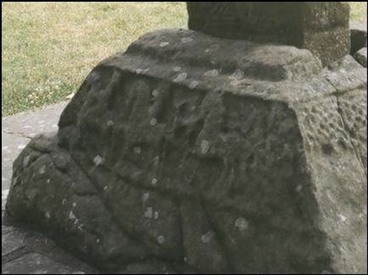
Kells South; Horsemen and a Chariot: This scene and the two below from Ahenny North are related as Helen Roe remarks. “Two horsemen, mounted on steeds with proudly arching necks, ride before a chariot in which are two persons. A dog runs alongside but, owing to the space available, is shown on a level with the horse’s rump.
“Chariot processions appear quite commonly on Irish crosses, the finest version being on the base of the N. Cross Ahenny (below); this rendering seems a simplification of it.
“The significance of these scenes is not known. I would suggest that they possibly represent a Transfer of Relics, such as is depicted on a 6th century ivory plaque preserved in Trier Cathedral.” (Roe p. 19)
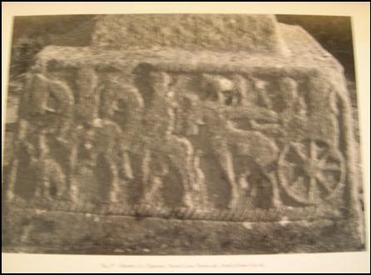
Ahenny North; Procession with Chariot: [photo fromHarbison, vol 2] This scene differs in at least three ways from the one above. A bird is just below the raised hoof of the lead horse. The dog is farther back and raised on what Harbison identifies as “standing on the chariot pole” (Harbison p. 13) In addition, the passenger in the chariot appears to have on a cowl and to have one foot raised up as if he were reclining.
If the passenger can be identified as a monk, this would lend support to Roe’s suggestion that it represents a transfer of relics. Could the leg actually be the relic? The photo below is from Henry p 51.
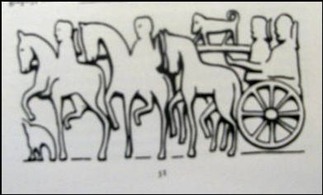
References cited:
Allen, J. Romilly, The High Crosses of Ireland, Kessinger Publishing’s Rare Mystical Reprints. 1887 Lectures on early Christian symbolism in Great Britain and Ireland
Crawford, Henry S.; Handbook of Carved Ornament: From Irish Monuments of the Christian Period. Royal Society of Antiquaries of Ireland, Dublin, 1926.
Harbison, Peter; The High Crosses of Ireland: An Iconographical and Photographic Survey, Dr. Rudolf Habelt GMBH, Bonn, 1992. Volume 1: Text, Volume 2: Photographic Survey; Volume 3: Illustrations of Comparative Iconography.
Henry, Francoise; Irish High Crosses, Three Candles LTD., Dublin, 1964.
Konstam, Angus, Historical Atlas of the Celtic World, Thalamus Publishing, 2001.
MacGowan, Kenneth, Clonmacnois, KAMAC Publications, Dublin, 1985.
Roe, Helen M., The High Crosses of Kells, Meath Archaeological and Historical Society, 1988.